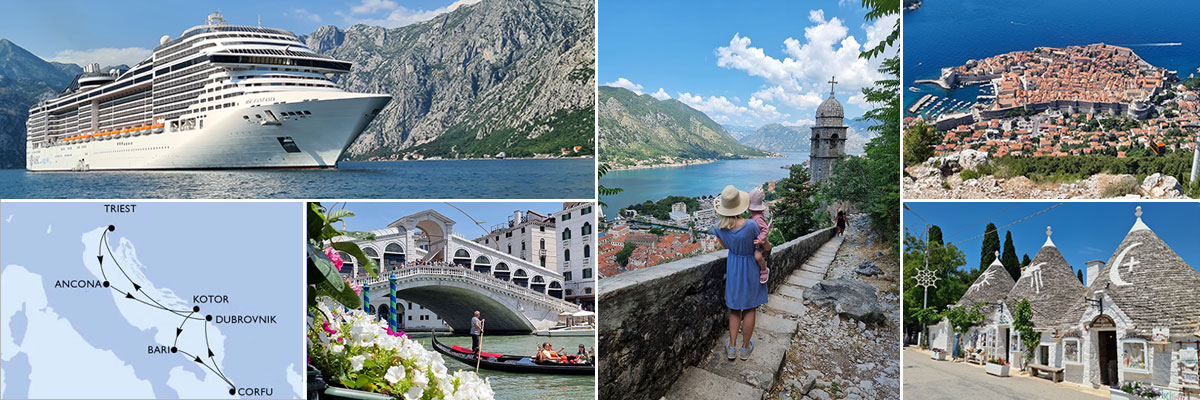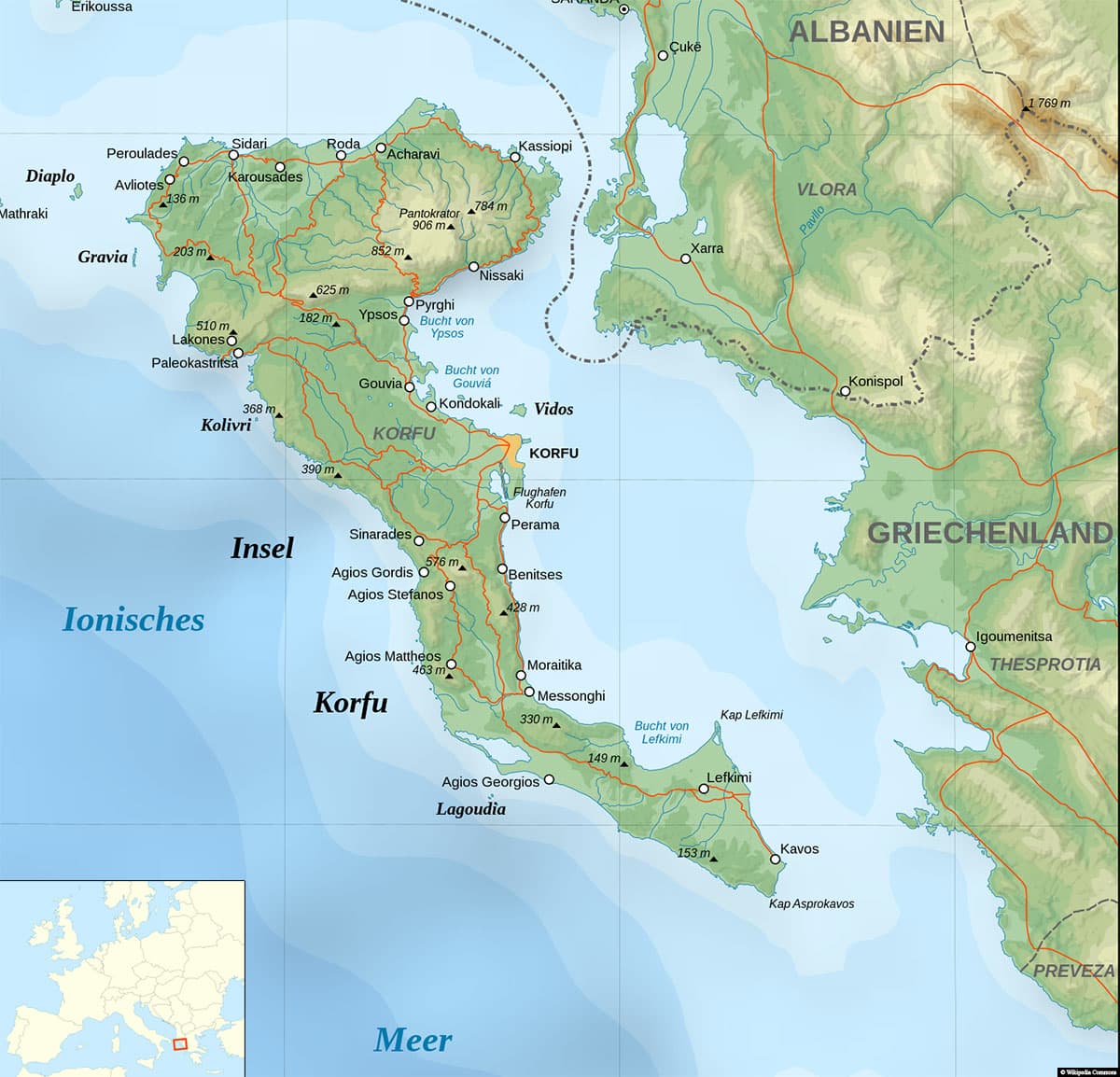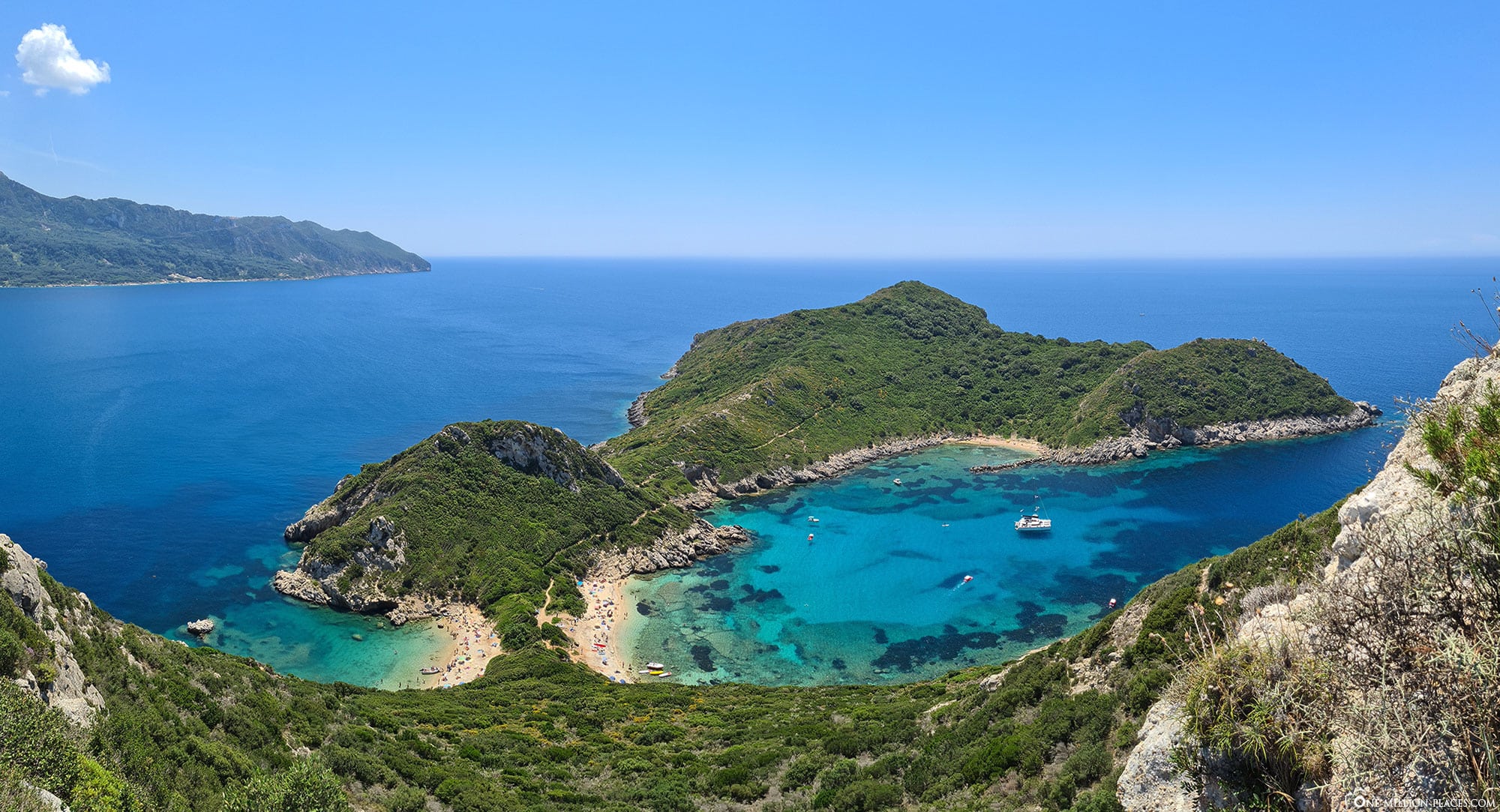We were thrilled to have a stop on the Greek island of Corfu as part of our MSC cruise through the Adriatic. We have been able to explore several Greek islands so far, such as Santorini, Mykonos, Milos, Kefalonia and Crete and were totally thrilled by the flair and the places on the islands every time. On Corfu we took a rental car for a day, drove around the island and were able to see some very beautiful places on the island: Nature lovers, beach lovers and culture enthusiasts will definitely get their money’s worth here 🙂

Table of contents
Things to know about the island of Corfu
Corfu has a total area of 585 km², making it the second largest Ionian island and the seventh largest island in Greece. There are about 115,000 inhabitants living on Corfu. The island extends over a length of about 60 kilometers off the Albanian and Greek west coast in the Ionian Sea; in the north it is even only 2 kilometers away from the Albanian mainland. Due to its vegetation and balanced climate, Corfu is very often called “the green island”. The landscape is characterized by two rugged mountain ranges that divide the island: in the north of the island the mountain range of Pantokrator (up to 911 m high) and in the center the mountain ranges of Agii Deka with 576 m high.
Corfu has an interesting cultural heritage, as the island was once under Venetian, French and British rule before falling to Greece in 1864. This is also reflected in the architecture that one encounters on the island. For Germans, the island is one of the most popular vacation islands in Greece, along with Crete, Rhodes and Santorini. Numerous Britons and Italians also spend their vacations on the island. Corfu is therefore in some places, especially in the summer and vacation season, already very touristy – we noticed this especially in Corfu Town very much.
Cruise ship dock & our rental car
Corfu Port is located about 2.5 kilometers outside the island’s capital Corfu Town. It consists of a harbor building and a long breakwater that runs at right angles in the harbor. Ferries dock here, which for example. coming from Italy, but also the big cruise ships. We read that apparently up to 7 cruise ships can be handled in one day. Together with us, another ship from Norwegian Cruise Line was in port that day. Our ship was at the end of the pier, so the walk to the harbor exit took about 15 to 20 minutes. By the way, there is also a free shuttle bus between the ship and the port building, which runs at regular intervals. In the port terminal there is, among other things, a small tourist information office, but also a cab stand and a counter of a car rental company (Royal Car Rentals).
We researched online for quite a while in advance to find a suitable rental car for our day in Corfu. The provider in the port was too expensive for us, so we opted for another car rental company that has its office a little outside the port. We rented our car with Corfu All Year for 80 EUR/day incl. Child seat and all insurances. The car was already cleaned in front of the door when we arrived. The rental and return was quick and uncomplicated, so we can definitely recommend the provider. The car – a Nissan Pulsar Automatic – was also immaculate and very new.
The limestone cliffs at Cape Drastis
Our first port of call on the island is probably THE highlight of Corfu: Cape Drastis is located in the northwest of the island and can be reached from Corfu Town within about 1 hour by car. The 40-kilometer drive takes you through the green countryside and hilly mountains until you reach a small parking lot. This is also where the asphalt road ends. If you are lucky, you catch a free space in the small parking lot. If not, you have to stand on the side of the road.
From the parking lot, a rocky, somewhat steep trail descends to the shore of the Cove of Grava. Purely theoretically, you can also drive this way by car, but we would not recommend this, because the road is very uneven and has many potholes. After a 10 minute walk you can already enjoy beautiful views of the green-blue shimmering sea and Cape Drastis. Simply breathtakingly beautiful!
Cape Drastis is the most northwestern point of Corfu and an absolute postcard motif: an extraordinary rock formation winds here from the land into the turquoise sea and forms a small bathing bay in the middle. Simply picturesque! Due to its steep vertical walls dropping directly into the sea, the cape is not accessible. But that’s not bad at all, because the view from the various vantage points is the most beautiful anyway. We didn’t walk all the way down to the coast, just to the viewpoints halfway down. After that we went back to the car, because we wanted to see some other corners of the island.
The double bay Porto Timoni
The most beautiful beaches of Corfu are located along the north and west coast. And two of them we really wanted to see: the twin beaches of Porto Timoni. For this purpose, we headed for the mountain village of Afionas, which is located on a small promontory that juts picturesquely into the sea. We drove into the village until we could go no further… and right here is a large, private parking lot where you can park your car for 5 EUR/day (link in Google Maps). We continued on foot through the small village, passing bright stone houses, huge colorful bougainvillea plants and small stores selling local products.
We passed the small snack bar “Canteen Afionas Corfu”, which by the way is highly recommended for a snack and cold drinks, to get on the path that would lead us to the Porto Timoni Viewpoint. The path is sandy, occasionally stony but good to walk even in sandals. After a while you come to a fork in the road that leads down to the double bay on the left (“Porto Double Bay”) and to the viewpoint on the right (“Cartieri”). Since we only wanted to get to the viewpoint due to time constraints, we chose the right path and reached our destination after a few minutes. There was no one else there, just us – how cool 🙂 The view of the double bay of Porto Timoni is just breathtakingly beautiful: Two beaches, one more beautiful than the other, turquoise-blue water glistening in the sun and in the background a green, hilly mountain landscape. We stood up here for quite a while and let the panorama work its magic on us.
On the way back we had a snack in the small snack bar and then continued our sightseeing program on Corfu.
The monastery Vlacherna
About 5 kilometers south of Corfu Town there is another postcard motif that can be seen in almost every report on Corfu: the view from Kanoni to the monastery island of Vlacherna and the“Mouse Island” (Insеl Pоntiκοnissi) behind it. The small monastery island can be reached via a narrow breakwater from the mainland. Here is the former nunnery with a small chapel built in 1685 in honor of the Virgin Mary. Today the monastery is no longer in operation. However, the church can be visited for tours and prayers and there is a souvenir store in the monastery courtyard.
The sights of Corfu Town
In the afternoon we headed for the island’s capital Corfu Town (Kerkyra), which is the only major town on Corfu. We parked our car in a free parking lot at the Esplanade / Spianada Square (link in Google Maps) and easily explored the city on foot from here. The Esplanade is located directly between the Old Fortress and the Old Town and is a perfect starting point for a city walk.
Corfu Town has about 34,000 inhabitants and is the administrative and economic center of the whole island. The mixture of Venetian architecture and Greek lifestyle gives the city a special flair. Despite all this, it is just as touristy as other cities: there are souvenir stands everywhere, tourists sit in cafes & restaurants and passengers from the big cruise ships push their way through the alleys here.
The Old Town (UNESCO World Heritage)
The 70-hectare historic old town is the heart of Corfu Town. It is located on a promontory that extends into the Ionian Sea and has been a UNESCO World Heritage Site since 2007. As we strolled through the winding, cobblestone streets, we could see numerous pastel-colored buildings reminiscent of some 400 years of Venetian rule on Corfu. But the city is also characterized by French and British influences, only the oriental style is completely missing. It feels more like being in Italy than on a Greek island – you won’t find the white-blue Cycladic houses here either.
Directly on the esplanade is the Liston, a short arcaded street that invites you to linger during the day and at night. On Platia Dimarchiou, the town hall square, stands one of the most beautiful buildings in the city: the town hall, built in 1663. Once built as an assembly hall and later used as a theater, it was converted into the town hall in 1903 and today it shines with various reliefs on the building. A striking feature of the old town is the church of Agios Spyridon, built in 1590, with its impressive bell tower completed by a striking red dome. The church is considered a pilgrimage site, as it houses the bones of the patron saint in a silver sarcophagus.
During our walk through the (old) city we saw many more beautiful buildings and churches, like the Museum of Asian Art, which is located in the former Governor’s Palace (St. Michael and George Palace). In the immediate vicinity of the museum, we discovered Mandrakina’s St. Mary’s Church, which is a real eye-catcher with its pink-red color.
It is definitely worthwhile to take a look into the narrow, quiet side streets of the old town – sometimes beautiful photo motifs are waiting here! Otherwise, numerous small squares, churches and chapels as well as cafes and taverns invite you to linger and store.
On the western edge of the old town is the New Venetian Fortress, completed by the Venetians in 1645, which looks very massive and linear. Under the fortress run many underground passages that reach to and connect the Old Fortress and other places in the city. Unfortunately, the New Fortress was largely destroyed during the Second World War. After renovation and restoration work, it now hosts various exhibitions and is a venue for concerts and other art activities. From here you also have beautiful views of the old town and the old and new harbor.
The Old Venetian Fortress
The second fortress building that dominates the urban landscape of Corfu Town is the Old Fortress, located directly opposite the Esplanade. The fortress is located on a promontory where the old town of Corfu, built in the Byzantine period, was originally located. Between the 15th and 18th centuries the Byzantines began the construction of the fortress and the Venetians completed it.
About the in the 20th c. The main gate of the fortress can be reached via a stone bridge and the interior of the fortress can be visited for an entrance fee. Unfortunately, we had no more time for it, so the view from the outside was enough for us. Inside the fortress there are some interesting buildings to admire, such as the ruins of a former British hospital and the church of Agios Geórgios, built in 1824 and modeled after an ancient Greek temple.
Today the fortress houses a museum with Byzantine sculptures and paintings, as well as the Corfu Public Library, housed in the old British barracks. In addition, the fortress grounds are also used for various art and cultural exhibitions. Part of the university is also located in the Old Fortress.
All travelogues of our cruise through the Adriatic Sea
We deliberately chose the 8-day cruise with MSC Cruises from Trieste, as it included some places that had been on our bucket list for a long time. In total, our trip took us through four countries: Italy, Montenegro, Greece and Croatia. We were able to experience six eventful and varied days on land: We started in Trieste, then continued to the port city of Ancona, through the breathtaking Bay of Kotor to Bari. The journey continued to the green island of Corfu and to medieval Dubrovnik with its impressive city walls, from where we returned to Trieste. Since our plane left from Venice, we were even able to make a small detour to the gondola city, which was another highlight of the trip. Cruise Day 1 » MSC Cruises – Cruise with MSC Fantasia in the Adriatic Sea
Cruise Day 1 » MSC Cruises – Cruise with MSC Fantasia in the Adriatic SeaCruise Day 1 » Trieste – Sights & the best Photo Spots in one day (Italy)
Cruise Day 2 » Ancona – The most famous sights in the old town (Italy)
Cruise Day 3 » Kotor – Bay, old town and fortification (Montenegro)
Cruise Day 4 » Bari – Top sights & photo spots in the old town (Italy)
Cruise Day 4 » Alberobello – A day trip from Bari to the Trulli houses (Italy)
Cruise Day 5 » Corfu – Discover the island in one day (Greece)
Cruise Day 6 » Dubrovnik – Top sights & photo spots in one day (Croatia)
Cruise Day 7 » Day at Sea
Cruise Day 8 » Venice - The most famous sights in just one day (Italy)


